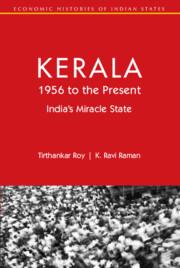Book contents
2 - Before Independence
Published online by Cambridge University Press: 31 May 2024
Summary
In the early nineteenth century, the region was ruled by three main political entities: the British Indian district of Malabar belonging to the Madras Presidency, Cochin state, and Travancore state. This was what the southwestern coast's political map looked like for 150 years before the three units were merged to form Kerala (1956). Despite this difference in political form, the three units experienced rather similar forces of change since the nineteenth century, such as the commercialisation of farming and plantations that expanded into new land frontiers, the influx and mobility of capital, labour migration, social movements targeting harsh inequalities and the decline of landholder power.
This chapter will describe the change and its legacies in the mid-twentieth century. It is helpful to start with the eighteenth century, when the political balance faced new challenges before settling down.
Trade and Politics in the Eighteenth Century
A serious European engagement with the southwestern coast of India began with Portuguese explorations in the late fifteenth century. From much before, Malabar traded with West Asia and Africa. ‘Nowhere in India,’ wrote D. M. Dhanagare, ‘have foreign trading and commercial and religious interests interacted within the indigenous socio-economic and political institutions more intimately than they have in Malabar.’
The chief exports of Malabar in early modern trade were spices and timber. Teak was abundantly available. A large shipbuilding industry developed, dependent on the custom of local ship-owning merchants. Beypur was the principal port in Malabar, where much of the commercial and shipbuilding activity was concentrated. In 1498, the Portuguese mariner Vasco da Gama landed in Malabar. A subsequent Portuguese attempt to impose a licensing system on coastal trade produced intermittent conflicts with the ruler of Calicut (Kozhihode), his allies inland, and a resistance force created by the Muslim merchants operating in the seaboard. The Portuguese attempt failed in the end, and the centre of Portuguese settlement shifted further north.
The cosmopolitanism of Malabar strengthened further in the second half of the eighteenth century under two forces, one maritime and another inland. In the seventeenth century, Dutch and English traders arrived to take a share of the lucrative spice trade.
- Type
- Chapter
- Information
- Kerala, 1956 to the PresentIndia's Miracle State, pp. 16 - 40Publisher: Cambridge University PressPrint publication year: 2024



